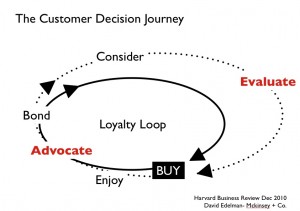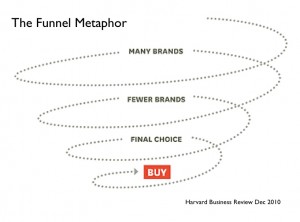Parallel Worlds: Integrated Campaigns, The Funnel and the Customer Journey
Manolo Almagro, Q Division Managing Partner
The “Marketing Funnel” has been the mainstay for mapping consumer behavior and where brand’s should focus the majority of their media spend. We as an industry created a mashup version of the Funnel + the Customer Journey – to rationalize where digital OOH fits in the path to purchase.
“The right message, at the right place, at the right time” mantra has long held the number one slot on top 10 hits of buzz phrases. These days, this specific phrase is on my top five statements that make me cringe; along with “the internet isn’t working”, “I’m Facebooking” and “let’s make it viral”
For years, I’ve tried my best to evangelize the concept of “integrated digital campaigns” to an industry that sticks its fingers in its ears while it makes “blah-blah-blah” noises in order to block out any messages that contradicted DOOH’s supremacy. Meanwhile, its was just a matter of time before mobile and social media became the primary way consumers made purchase decisions.
I’d like to bring to everyone’s attention to the recently published consumer behavior study from Mckinsey + Company that was the subject of an article in The Harvard Business Review. I liked it because it validated what I’ve been saying – about how people now make their purchase decisions way before they get to the store. It explains that the time to influence purchase is during the evaluate and advocate phase, rather than the consider and buy phase. You can read all the details in the December 2010 issue of Harvard Business Review Magazine, just look for the article “Branding in the Digital Age, You’re Spending Money in All the Wrong Places” As soon as you can.
 I submit to the industry that it’s time to adapt to a more relevant strategy that helps define the role of DOOH in the newly crafted Customer Decision Journey concept. As the McKinsey study indicates – The “Customer Journey” and marketing funnel paradigm are less relevant to the new race of people that use digital channels to build their own insights, do their own product research, find reviews, and community advocacies. It’s these channels that are the most effective in helping people decide what product they want to buy as well as endorse.
I submit to the industry that it’s time to adapt to a more relevant strategy that helps define the role of DOOH in the newly crafted Customer Decision Journey concept. As the McKinsey study indicates – The “Customer Journey” and marketing funnel paradigm are less relevant to the new race of people that use digital channels to build their own insights, do their own product research, find reviews, and community advocacies. It’s these channels that are the most effective in helping people decide what product they want to buy as well as endorse.
So, where does DigitalOOH belong in this new, new world order? Well, it depends on who you ask. The industry has fractured into various “denominations” – where some people have found religion and others have stumbled across something else.
There are die hard industry folks that cling dearly to the belief that digital will never be usurped by other digital media (smartphones or otherwise) – and therefore, they continue to create campaigns that isolate the dynamic digital surface as the primary engagement component of a campaign strategy.
Then there’s the sect that believes the future of digital OOH is to run specialized social media feeds that allow people to use their mobile phones to post shout-outs to their friends – totally disregarding the fact that people don’t want to wait around for their posts or comments to show up in the social media stream running on the screens, as they just don’t have the patience or the time.
There’s a third denomination of industry believers that look to sensors, facial recognition and on-demand artificial intelligence playlist generation as the key to making digital OOH hyper-relevant.
However – none of the above mentioned schools of thought address the newly established consumer behavior of making a purchase decision prior to entering the retail environment, not to mention that it’s highly likely that if a consumer’s bond to a product/service is strong enough then the repurchase decision circumvents any earlier decision journey stages.
As more and more brands and marketing agencies shift their attention to channels that help with advocacy and evaluation, where does that leave in-store digital? Sure – Digital Outdoor has its place in creating awareness – but if the decision for purchase is swaying away from in-store? What role can digital OOH play?
I plan to dedicate a significant amount of time to answer these questions in the coming months as part of my weekly (or monthly) posts on the DailyDOOH. Stay tuned…


February 15th, 2011 at 09:09 @423
Thumbs up, Manolo for a great point of view.
Even with all the buzz going on, I sometimes wonder if this “industry” really isn´t an industry, but that digital signage will end up as one of many “applications” for marketing. It still hard to find DS vendors with extreme financial growth rates, large M&A deals and booming bottom line earnings numbers.
It´s not hard to figure out why human contact in form of interacting with a real person (the staff) and interacting by proxy (through smarthpones and social media) beats the non-human contact of DS displays (and TV ads).
Not that displays can´t be useful in many ways, but I agree on not overestimating the value.
February 15th, 2011 at 13:41 @612
Great to read your ideas and thoughts on the matter!
Integrated digital campaigns work well if the strategy and concept are aligned with what the consumer wants.
Digital signage is part of the media mix and needs to be considered as a ‘part of’ and not ‘the one-and-only’ in order for it to be effective.
Once the ‘industry’, agencies and brands start focusing on the entire journey and most importantly consumer behaviour, as mentioned… then DS will finally be part of the integral marketing strategy.
Until that day, I hope there are more like minded individuals who get this message
out there.
Looking forward to reading more of your posts dedicated to this subject.
February 15th, 2011 at 15:16 @677
Excellent points.
As an advocate for all screens being connected, I’d like to point out that the idea of literally interacting with screens is often misunderstood – especially in DOOH where at mobile and social applications are often applied like “lipstick on a pig” (ie an afterthought rather than strategic implementation).
In use cases where there is ample dwell time (e.g. in bars, stadiums, conferences etc) and user motivation, interactive applications can be very engaging – but in so many other areas, what we call passive or active place-based social media are better ways to leverage the power of social media via other screens (mobile and/or web) and have continuity of messaging and experience. With passive and active place-based social media, the user does NOT expect to see DOOH screens update in real time , but can use web or mobile screens as part of a continuum. This is a far more effective experience for the user and brand budgets, but it still requires DOOH networks to understand the strategic importance of connecting beyond beyond their walled gardens.
Stephen Randall
February 16th, 2011 at 10:06 @462
Very interesting comments.
We are fortunate at Subtv that the audience for our University network has very high dwell times, and a propensity to interact and communicate in as many ways as they are able.
At the moment we have an iPhone app (soon to be on Android / Microsoft / RIM) that allows interaction with this system as well as a touch screen at each site.
We have already seen very high useage of these channels with over 80,000 interactions in January covering music selection, voting, and dedications.
We are absolutely committed to the further development of this, and other, methods of involving, integrating, and engaging a willing audience. I know that we are not unique in taking this approach and I am sure that smartphone adoption is the catalyst that will drive this integration.
Peter